U.S History to 1877
Indigenous America, Pre-1600s
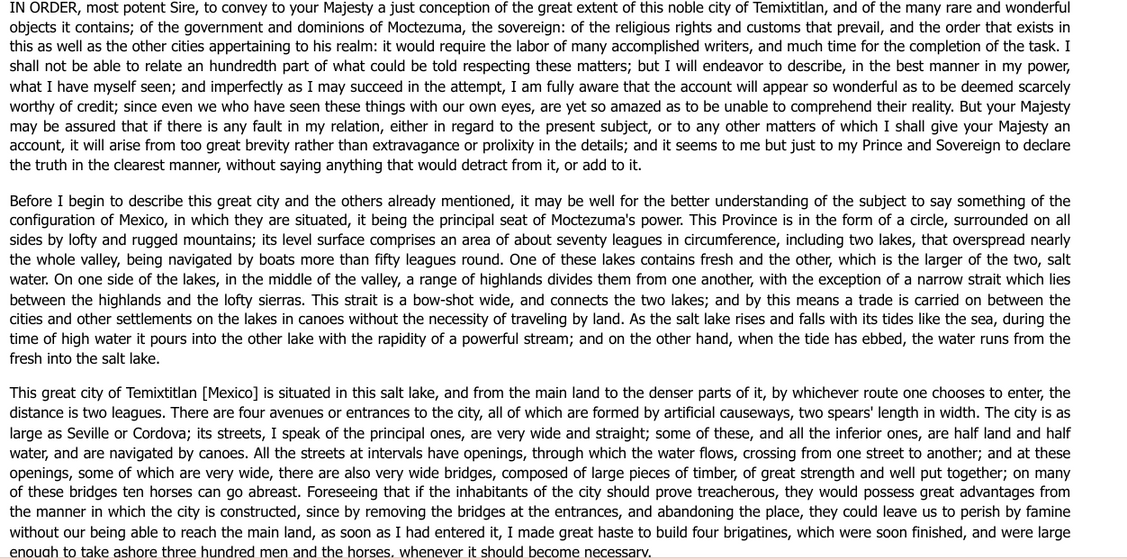
Oliver J. Thatcher, “Hernan Cortés: from second letter to Charles V, 1520,” Fordham University, https://sourcebooks.fordham.edu/mod/1520cortes.asp
Introduction:
Evaluation:
Before the 1600s, groups of people known as the Indigenous traveled from Asia to America across the Bering Sea. These groups settled all across America and many of them practiced nomadic lifestyles. During this time domestication of plants and animals began, leading to sedentary practices taking place. These groups built more permanent shelters and monuments, many of which can still be seen today. Societies began to form, creating the concept of social hierarchy. Big societies came into existence, creating networks of exchange as well as conflict between them.

This document was written by Hernan Cortés, as a letter written to Charles V. This was written to admire and explain the great extent of the city of Temixtitlan. This was written around the time of 1520 when the Spanish and Aztecs had begun to interact with one another. This was written in the city of Tenochtitlan, which is where Mexico City is located today. The accounts were collected by Oliver J. Thatcher, and published in the Library of Original Sources in 1907. The letter was written and intended for Charles V, who was the king at this time. This document describes the many features and uniqueness of this ancient city. It explains the architectural features, the landscaping, as well as the public features that the people of this city can take advantage of. This document explains what every corner of the city looked like, as well as a glimpse into what life may be like living here. It describes the temples, housing, the market, as well as important figures. These features are described with the admiration and thanks of Montezuma, as he was the ruler of the Aztec Empire at this time. These letters were written to Charles V to explain and describe some of his early discoveries of this city. He writes in the best way that he can to describe everything that the city holds within. He writes this letter as an admiration of the city and everything that is a part of it. His intentions are well as he writes this piece, as he knows he is not the best one to write this piece to the King.
Contextualization:
From this document, the ideology of religion is very present. We can see this describing the temples within the city of Tenochtitlan, emphasizing the principal tower of the church at Seville. In these principal chapels, only the ones who have the greatest confidence and faith are within. The people must believe in God rather than idols, as well as the idea that there was only one Universal God, and that he created all things. The ideologies of Civilization and Social Hierarchy are also present because Montezuma believed that those who were originally from the country were superior to those who came because of ancestors. He also believed that when these immigrants were to come, they must obey to everything that he says, as well as the people originally from this place. This letter summarizes what was happening in the Aztec Empire during this time, as well as the interactions between the people.
Colliding Cultures, 1600- Early 1700s
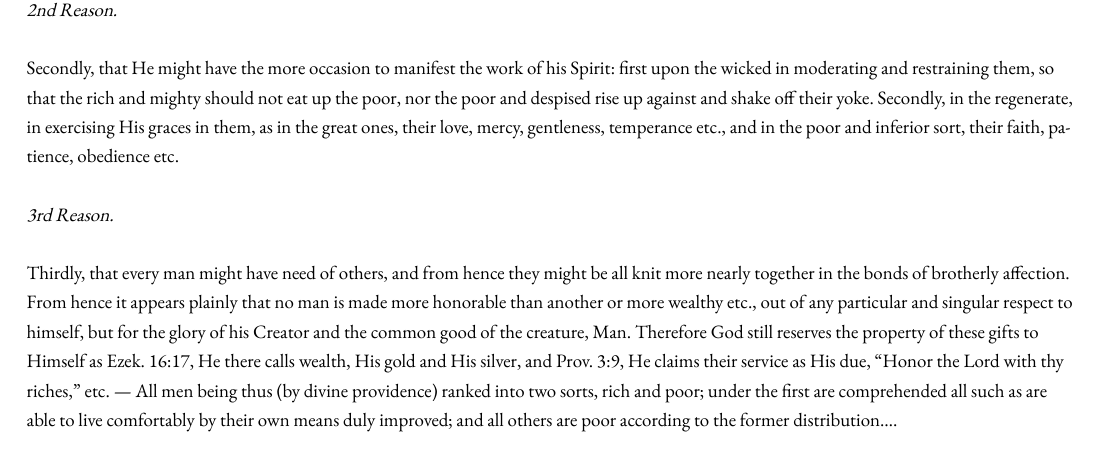
John Winthrop, “A Model of Christian Charity,” in A Library of American Literature: Early Colonial Literature, 1607-1675, Edmund Clarence Stedman and Ellen Mackay Hutchinson, eds. (New York: 1892), American Yawp, https://www.americanyawp.com/reader/colliding-cultures/john-winthrop-dreams-of-a-city-on-a-hill-1630/
Introduction:
As the groups increased entering new territories, there were many new changes impacting the Indigenous people. Many populations left Europe to enter the Americas. During this time a large number of African Americans were taken during the Transatlantic Slave Trade. In this period there was new contact between the Indigenous groups and the Europeans. Many of these new groups had both positive and negative interactions with each other. This time period guided new ideas about race and slavery and had a major impact on American Slavery that would influence United States history.
Evaluation:
This document was a sermon given by John Winthrop before his fellow settlers reached New England in 1630. He wanted to set the expectation that the Massachusetts Bay would act as an example to the world, and how he wanted them to stand out from the rest of the world. Throughout this speech, he describes his reasoning for this dream that he has. He explains how he wants to be able to glorify God, solve economic discrimination, and how he wants everybody to get along. He believed that by doing these things and setting an example for everybody to look at, his Church would stand out and be recognized for making change. Winthrop describes the ideas that he has to make this new world a better place. He emphasizes that he doesn’t want any recognition for any of this, that all of the wonders done are done through God, and that this new church is entirely in His plan. This sermon was an inspiration to many and gave the people confidence that this was all going to work out.
Contextualization:
During this time, the ideology of religion was very present. Each group and tribe had their views on religion, so when they all combined it caused some dispute. The Puritans for example are the ones mentioned in this document, and they wanted to build their society completely on their spiritual beliefs and to influence other societies. On the other hand, the Spanish created Catholic missions in which they wanted the Indigenous people to embrace the Catholic religion. Civilization is also very relevant in this period because of the constant expansion and new groups entering the Americas. Many of these new people had to change their beliefs and norms to better fit in with this new population. Throughout this document, the ideology of religion is extremely present with the Puritans. This can be seen throughout the entirety of this sermon. Winthrop is trying to persuade and inspire the people that this new church will be in the hands of God, and that it will act as an example for the entire United States. During this time each European group had their ideas and views on religion, which is why this sermon was unique and stood out. Winthrop is almost trying to push religion on the people and persuade them that this new church will make history. The ideology of Social Hierarchy is also present in this sermon because of the wishes that Winthrop makes. He states that nobody is more wealthy or honorable than anybody under the eyes of God and that he will have the same practices in his church. He also wants the people to take their wealth and give it to the church as well as those in need so that it doesn’t act as a difference between the people in this new church. He describes that the people need to be there for each other and help with everybody’s needs, no matter what. This sermon summarizes the desires that Winthrop has for this new church, as well as this new community.
Colonial Society, 1600s-1760s
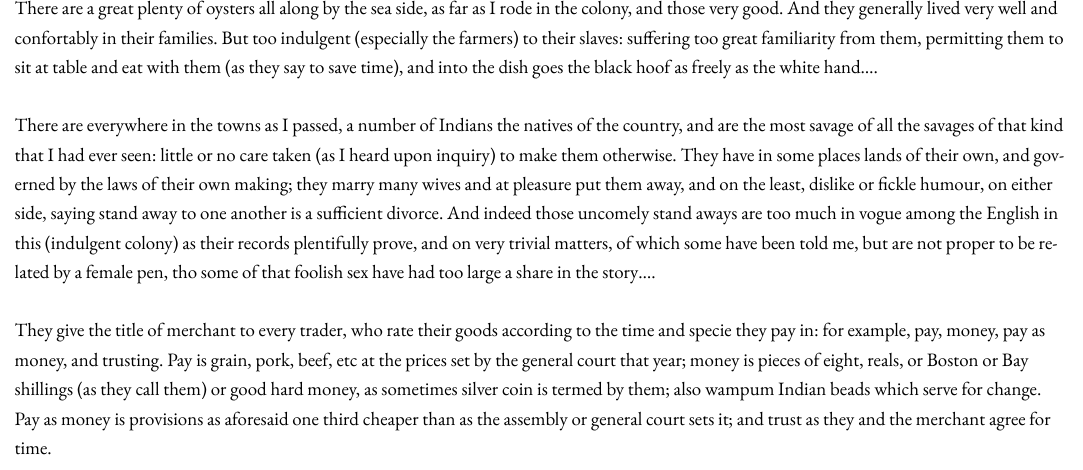
Sarah Kemble Knight, The Journal of Madam Knight, With an Introductory Note by George Parker Winship (Boston: Small, Maynard & Company, 1920), 36-43, American Yawp, https://www.americanyawp.com/reader/colonial-society/boston-trader-sarah-knight-on-her-travels-in-connecticut-1704/
Introduction:
Evaluation:
During the 1700s colonists had settled across different cities across the East Coast. Some of these areas of settlement included Boston, New York, Charleston, and Philadelphia. Philadelphia has the largest population. As these colonies continued to evolve more people, buildings, and government came into existence. Society started to develop through an urban lifestyle. The laboring class included enslaved people and workers which was the lowest level in their society. Other common workers made up the middle class while those who were high in trade and politics made up the highest area of society. Slavery was seen throughout all 13 colonies and was extremely common at this time. Slaves worked in homes, farms, and large plantations. Throughout this time slavery continued to gain popularity and became more common throughout the colonies.
This document was a segment of a journal in 1704 from Sarah Kemble Knight, who is traveling from her home to Massachusetts in order to exchange goods. She wanted to document her journey and what she discovered when traveling to a different colony. She explains what life looked like and felt like during this time, not only for the people of the colonies but also for the enslaved people. Throughout her exert she explains her observations that she noticed of both the interactions of the people and society as well as the landscapes. She goes into great detail about the living conditions and interactions that the enslaved people were experiencing. She explains what their working conditions are like, as well as offering a glimpse into their social lives. Towards the end of this entry Sarah goes into detail about the trade industry during that time and the inconsistencies within it.
Contextualization:
At this time, there were many new ideologies present in the colonies. As the colonies started to break away from the English and form their identities. This new concept of “individualism” played an important role in society during this time. In this journal, these concepts are not mentioned in great detail but rather inferred. Sarah explains how the people in Boston had begun to work more independently and provide more for themselves. They began participating in trade throughout the colonies, in a way to prove that they could survive on their own. The colonists also identified with a new type of freedom and independence, one that they could not fulfill under British rule. Another ideology that became extremely present was the concept of racial indifference and slavery. Sarah emphasizes the inequalities and challenges that those who were enslaved had been experiencing. She explains the treatment that they received from their owners, the conditions that they worked in, and what their personal family lives were like. Tobacco was the most popular crop as there were many plantations at this time. It is consistent throughout this journal entry that the lives of the colonists were new and adaptive, and the lives of the enslaved were continuing to deteriorate.
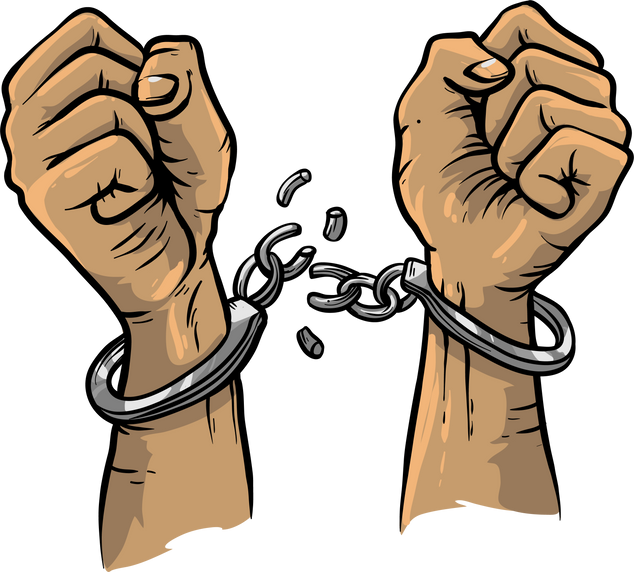
Revolutionary Era, 1760s-1780s
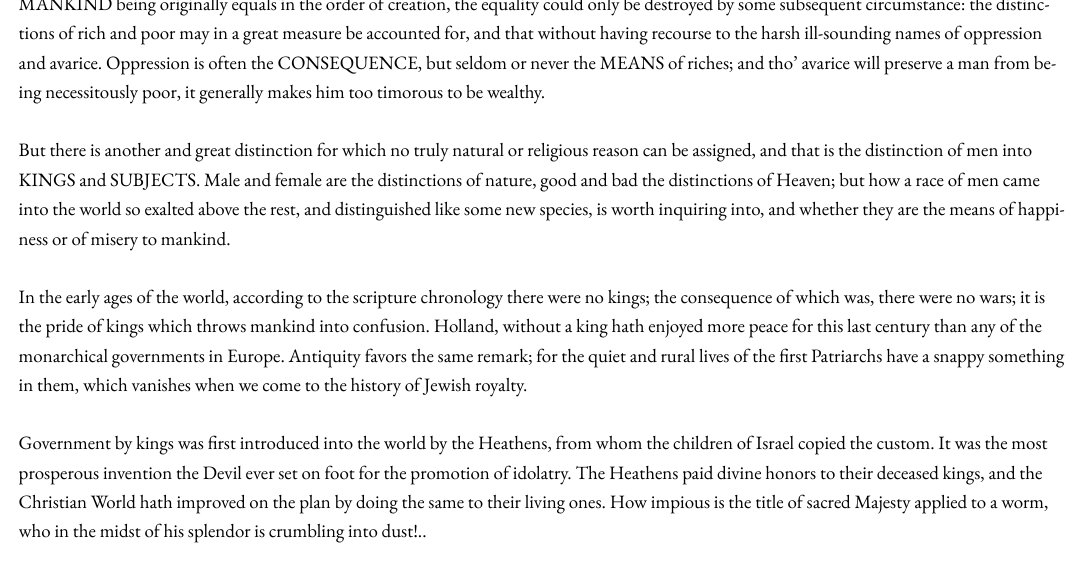
Thomas Paine, Common Sense (Project Gutenberg EBook: June 2008), Internet Archive, American Yawp, https://www.americanyawp.com/reader/the-american-revolution/thomas-paine-calls-for-american-independence-1776/
Introduction:
The main reason for war is rooted in political agreement. During this time many colonists were familiar with the term “Republicanism,” which encourages people to form a government that benefits society, is inclusive, and limits corruption. Many people in the colonies owned large amounts of land, so many of them participated in change. The concept of Enlightenment had a major impact on the colonies during this time. John Locke argued that no person was better than one another, but rather it depended on the individual circumstances in which they grew up. Many of the colonists used these ideas to form the concept of “Republicanism.” They were worried that the government would have too much power and control and believed that the public good should take priority. As the colonies continued to break away from Britain, the British took advantage of the colonies to cover their debts. They placed high taxes on them and limited the colonist's access to land.
Evaluation:
This document was written in 1776 by Thomas Paine, a man who formed the idea of Common Sense. He wrote this book to encourage the colonists to fight for Independence from Britain. Throughout this excerpt, he explains why the colonists needed to break away from the British government and gives them insight into what type of government they should form. He mentions how each person in the colonies deserves to be accounted for and treated equally, no matter what. He also talks about the dominance that men had during this time, and how they often act on both extremes of good and evil. He also explains how in the beginning of the world, there were no wars, and everything was run by a Monarchy. He introduces the way that Kings and Monarchs began to govern around the world, and explains how that has led us down this negative path. He criticizes this form of government greatly to emphasize how bad this form of government is for the colonies. Throughout this document, he is encouraging the colonists to veer away from this type of government and British power and to start fresh and take control for themselves.
Contextualization:
During this time the ideology of “Republicanism” was established. Correlated with this concept also came the new ideas of Freedom and Self-Government. In this source Thomas Paine has very strong opinions on the form of government that the British were using to control the colonies. He is encouraging the colonists to break away from this government and form their new one. He is encouraging them to fight for their freedoms, as well as offering them insight into the type of government that they should start. He wants the colonists to understand that they can form a new government on their own and that they don’t need British control. Another important ideology during this time was Gender Inequality. This idea is mentioned in this excerpt. Thomas Paine explains how males and females were both created under the nature of good. However, he goes on to explain how men have abused their power and have become this new type of “species.” He described this as how men have taken great power over women and other people in society. He ends this excerpt by explaining how it is unsure if men are “the means of happiness, or of misery to mankind.”
The Early Republic, 1780s-1820s
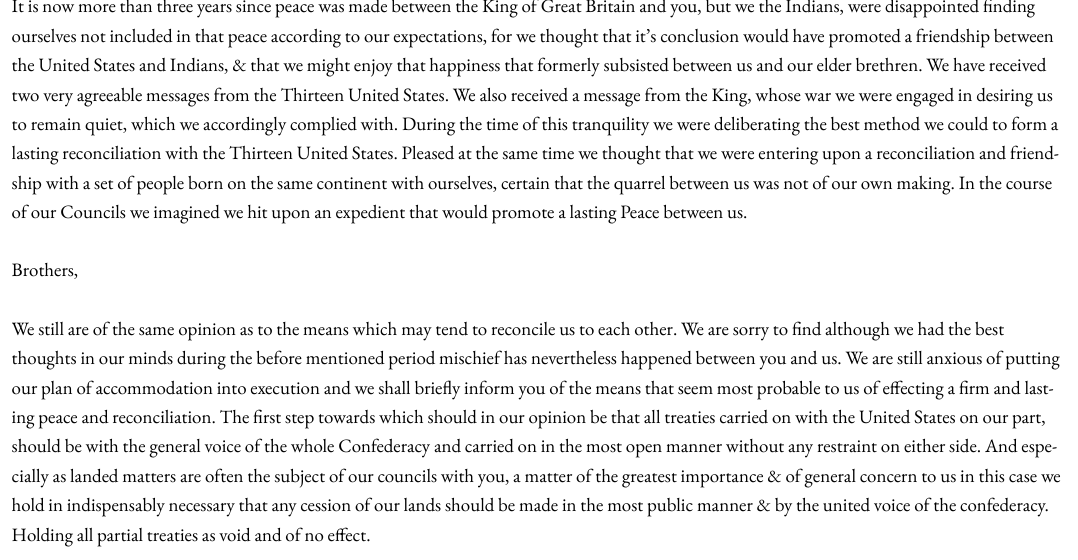
Speech of the United Indian Nations at their Confederate Council; 12/18/1786; Letters from Major General Henry Knox, Secretary at War; Papers of the Continental Congress, 1774 – 1789; Records of the Continental and Confederation Congresses and the Constitutional Convention, Record Group 360; National Archives Building, Washington, DC, American Yawp, https://www.americanyawp.com/reader/a-new-nation/a-confederation-of-native-peoples-seek-peace-with-the-united-states-1786/
Introduction:
Evaluation:
During this time period, the United States had begun a Revolution and started to work on how to become united as a nation. The populations were extremely diverse, the territories were spread out, and the government wanted to be created by the people, with the intention of being an advocate for the people. They wanted to create a new government and create the rights that they had not had the freedom to do under the power of Britain. However, the founding fathers who wrote the Constitution had different ideas than the colonists. During this period the United States had their first three presidents, created a constitution, and experienced new systems of war and enslavement.
This document is a speech given by the Indian Nations in 1786 and offers their point of view on what has been occurring during this time. The Indian Leader explains how their nations have been observing their freedoms as they have separated from Britain, but they feel like they have been disincluded and shut out. He explains how he thought that the United States and the Indians could have formed a friendship, but that is not the case. They were told by the King to remain quiet, but they believe that it is time they reconcile with the states. They want the outcome of peace between both of them and their alliance. In this document, he also explains the steps that they wish for the United States to take. The first one is that they want to be included in the treaties as well as be able to have some sort of voice in decision-making and contribution to the states. The overall goal of this speech was to unite a friendly nation between the states and the Indian tribes.
Contextualization:
During this time there was still the very present ideology of race and inequality between the people. Many of the Americans still had the strong belief that they were better than the indigenous and those of color, which is how the idea of “White Supremacy” came into existence during this time. During this speech given by the Indian Nations, the chief leader is asking to be included and respected by the American people, rather than left in the dust and ignored. We can infer that this was because the American people wanted nothing to do with the Indian tribes and they believed they would bring no benefit to their states. The Indian people were scared of the Americans and understood that they were looked down upon by them, which is why they attempted to ask for friendship in such a calm and innocent way.

The Market Revolution, 1800-1850
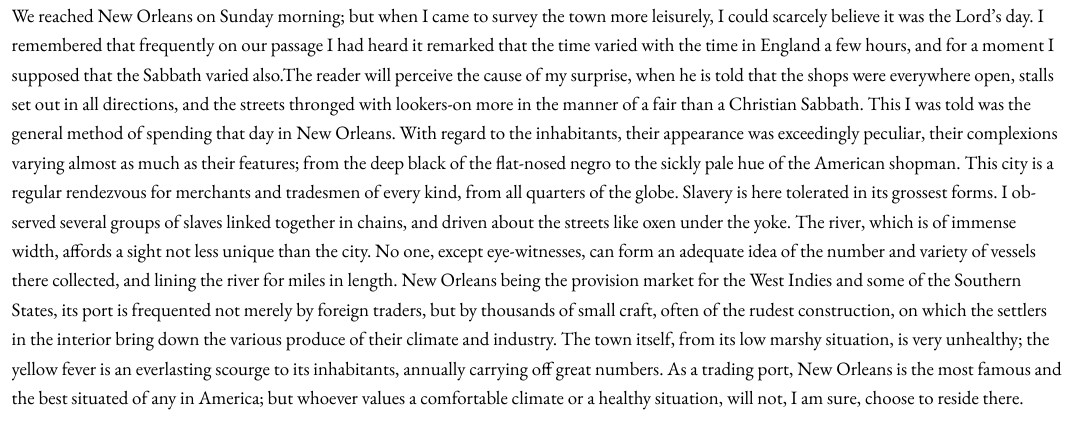
Rebecca Burlend, A True Picture of Emigration: Or Fourteen Years in the Interior of North America; Being a Full and Impartial Account of the Various Difficulties and Ultimate Success of an English Family who Emigrated from Barwick-in-Elmet, near Leeds, in the Year 1831 (London: G. Berger, 1848), American Yawp https://www.americanyawp.com/reader/the-market-revolution/rebecca-burlend-recalls-her-emigration-from-england-to-illinois-1848/
Introduction:
Evaluation:
During this time there were major changes that took place in the United States. New infrastructure and transportation led to major growth in the economy and started the Industrial Revolution that took place in the 1700s. Cotton Plantations continued to grow and spread throughout the United States. This expansion was influenced by the many new roads, canals, and railroads that made it possible to ship goods and materials over long distances. These goods were able to be transported to a variety of manufacturing centers in the North. Soon, factories began to take over many companies and shops. This revolution also led to changes in enslavement laws and norms. The North and South experienced a great divide during this time. The North began to emancipate and free many people, while the South continued to depend on slavery for their production and continued to expand slavery. The Market Revolution also saw changes in immigration, childhood, and gender relations.
This source explains a woman, Rebecca Burlend, and her family's experience as they emigrated from England to Illinois in 1848. She begins her journey in New Orleans and she describes what the city was like on a Sunday, known as the Lord’s Day. She was shocked to discover that life continued to go on like any other normal day in the city. In England, she was used to this day being treated sacredly, but it was completely different in the United States. She also describes how she observed many different groups of slaves, especially the way that they were treated and dragged throughout the city. Rebecca describes how she admired the variety of ports and canals within New Orleans, and how they got high usage from neighboring states and countries, making it one of the most popular in America during that time. While the trade and economy were doing well in New Orleans, there was a spike in Yellow Fever, taking the lives of many citizens. Overall, Rebecca describes her time in New Orleans as pleasant, but much different than she was expecting.
Contextualization:
During this time the ideology of Progress was extremely present and relevant to society. Throughout this source, Rebecca describes how in awe she is of the way that New Orleans is run. Throughout this era canals and rivers started to pop up throughout the country. New Orleans in particular participated in lots of trade and production with neighboring countries and states through the usage of their large canal. This is an example of progress and growth in the United States. Using these new resources made transportation and trade a lot easier and led to many new factories and companies, boosting production and the economy. Another continued ideology during this time period was Enslavement/Race. Rebecca explains how shocked she was to see the way that groups of slaves were dragged and treated poorly in New Orleans. She describes how they were chained together, and that she saw slavery here in its “grossest forms.” Slavery continued to expand and populate the South, and people of color were continually looked down upon.
Enslavement and Abolition, 1800-1863
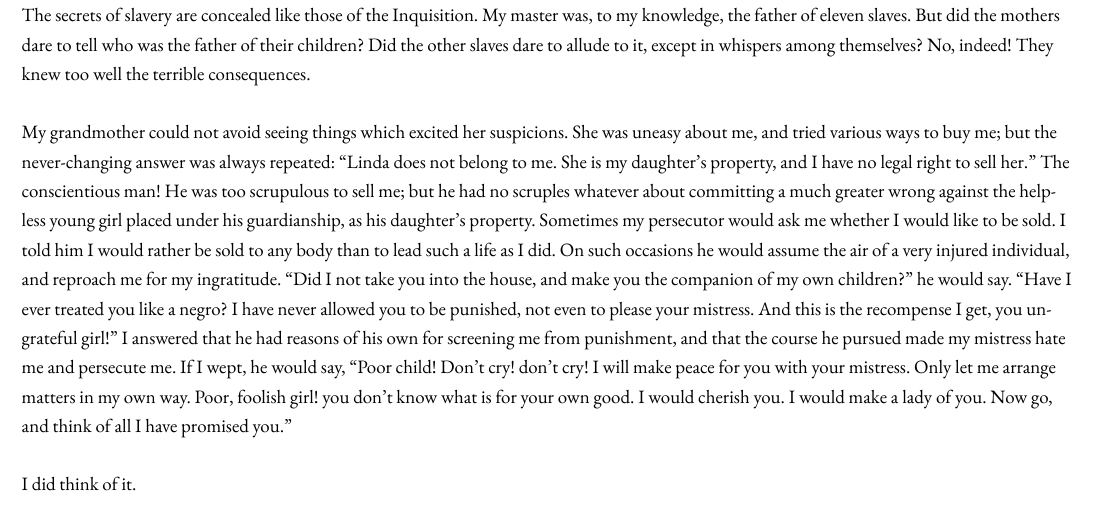
Harriet Jacobs, Incidents in the Life of a Slave Girl (Boston: 1861), 55-57, American Yawp, https://www.americanyawp.com/reader/the-cotton-revolution/harriet-jacobs-on-rape-and-slavery/
Introduction:
Evaluation:
During this time abolition and freedom were beginning to occur more and more throughout the United States. Not only were many slaves becoming emancipated, but abolition has now become extremely popular. These ideas had been renewed through the Second Great Awakening and the desire that the middle class had to reform during this time. Partial emancipation and total emancipation policies had become established, allowing for more slaves to become free. This was mainly happening in the northern states rather than the southern ones. In 1820, The Missouri Compromise prohibited slavery in almost all of the lands gained by the Louisiana Purchase. However, every measure and step that was taken could not stop the Southern states from participating in slavery. However, with the rise of social reform and efforts, the idea of abolition and getting rid of slavery became intense and popular in the North. The efforts made for anti-slavery eventually turned the minor movement into an extremely dominant and effective one. This was the beginning of the Abolition movement, which was extremely effective and important to where we are today in America.
This document describes the life of Harriet Jacobs and what her enslavement was like in 1860. Harriet was a born into slavery in North Carolina. She writes this document following her escape to New York. Throughout this document Harriet describes what really happened on her plantation and how her owners really treated her. She states that her master was a “father” to eleven total slaves, she being one of them. Harriet was referred to as property by her masters. They viewed her as unworthy and felt that she truly only brought sexual value and satisfaction. Her master also would verbally assault her and manipulate her with his words, wanting her to believe that the best place for her to be was on his plantation. He would punish her for acting ungrateful, and would threaten her each day. Her enslaver not only treated his wife Linda poorly as well, he made sure that every women that lives on his plantation was treated poorly, and made each of them extremely uncomfortable sexually.
Contextualization:
Throughout this time, many ideologies were common revolving around racial indifference. An ideology that was extremely present during this time period was the idea of Abolition and reforming American society. Many Americans were tired of seeing the ways that slaves were treated and many believed that it was extremely unjust. Additionally, it was hard to believe that slavery was still happening in the South when it had been abolished in the North. So, rather than just letting it occur, many people decided to do something about it and fight for those who were enslaved. In this document, it isnot directly talk about any abolitionists, but it talks about how Harriet did eventually escape from slavery. This was extremely difficult to do in the South during this time, so we can infer that she had help of some sort from other former enslaved people. Additionally, during this time women were highly looked down upon and mistreated/abused, which we can clearly see happening to Harriet in this document.
Manifest Destiny, 1830-1877
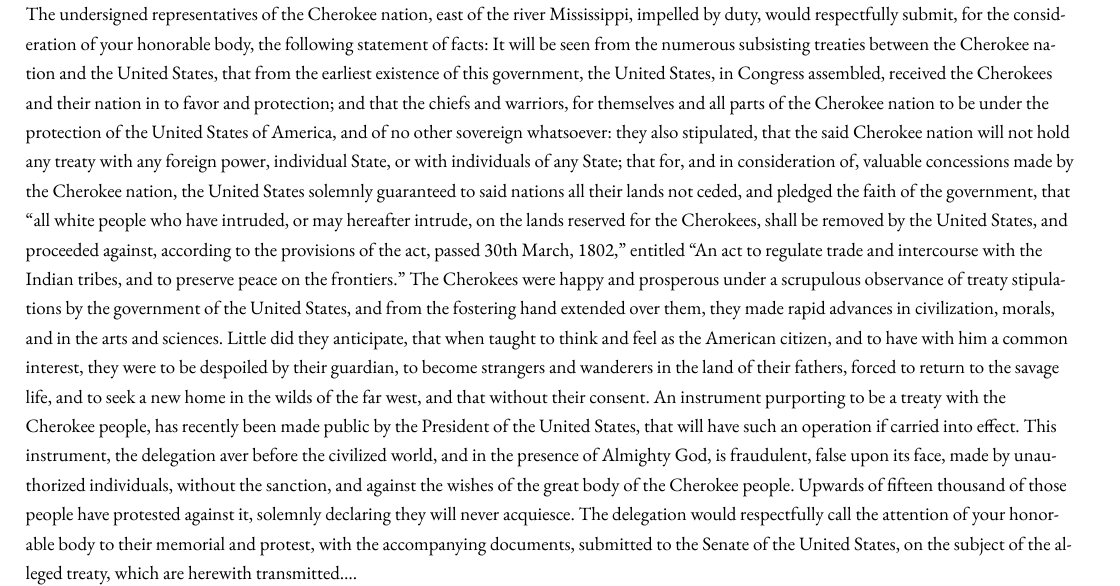
House Documents, Otherwise Publ. as Executive Documents: 13th Congress, 2d Session-49th Congress, 1st Session. United States congressional serial set. Doc. No. 286, pp. 1-5, American Yawp, https://www.americanyawp.com/reader/manifest-destiny/cherokee-petition-protesting-removal-1836/
Introduction:
Evaluation:
The Manifest Destiny took place during the Westward Expansion. In simple terms, it was the idea of bringing civilization to the West for the very first time. Following the Louisiana Purchase, the Westward Expansion took place in the early 1800s. In 1840, more and more territories had begun transitioning into states. During this time, many Indigenous groups were pushed out of their land in order to make way for new white settlers. Following the U.S.-Mexican war in 1848 the “Southwest” was officially incorporated into the United States. This same year, thousands of people began to move west. Migration was encouraged. Thousands of Native Americans moved west, which created many issues and disputes. Economically, the West was known for its railroads and cattle. Environmentally, bison were often hunted as well as more species of animals began to populate the West. By the year 1890, the United States declared the frontier to become closed.
This document described what life was like for the Cherokee group when they moved to the Americas. This was a Native American group, and as described throughout this document they decided to protest their removal in 1836. Even though many groups worked to adapt to American culture or try their best to be on their good side, the Cherokee did something very different. They decided to even make their own Constitution extremely similar to the one of the United States. They then tried to replicate American culture such as clothing, religion, economic activity, and speech. They decided to protest the laws of them being forced to move to the West in ways that the Americans themselves would have done. Through this constitution and protesting they describe how they feel like they were forced to come here, and that it was without their consent. The Cherokee group had over 15,000 people protesting in their favor.
Contextualization:
During the Manifest Destiny, there was a variety of ideologies. A major one was the ideology of “Manifest Destiny,” which was the idea that it was America’s destiny to bring civilization to the West. This is clearly seen in this document as the Cherokee was one of the groups that was forced to move west. This was something that was very common with many Indigenous groups during this time. However, it was not too common for the groups would protest the move, so that made the Cherokee group stand out a little bit. Another ideology during this time was the idea of progress by expanding the United States West. An example of something that was very progressive and dominant during this time was Bison. This animal was worth very highly and was hunted so quickly to the point of near extinction. The Cherokee group describes how they would hunt and participate in American trends like this one as they had to adapt to American culture. This describes the term progress as more activity was beginning in the west, and more people were populating in that area.
Civil War Era, 1850-1867
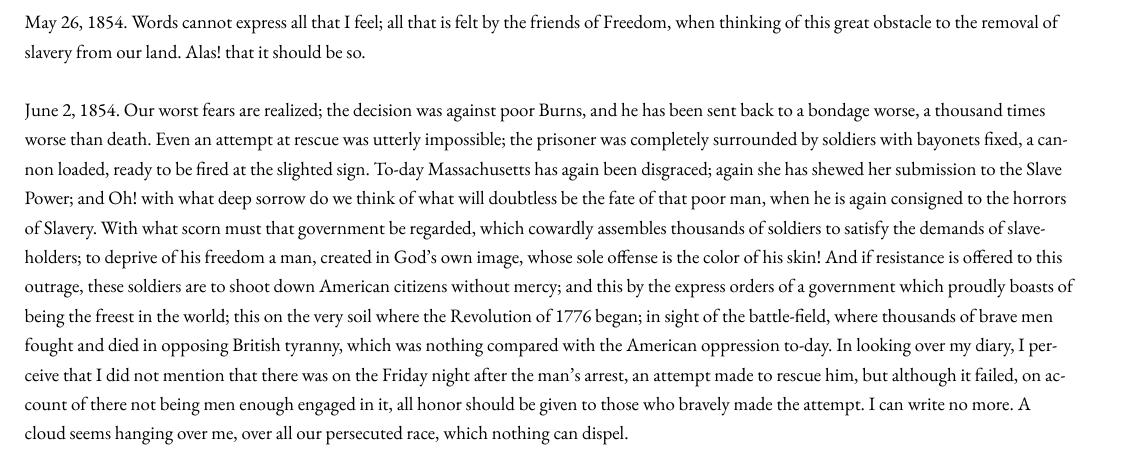
Charlotte Forten, The Journal of Charlotte L. Forten: Free Negro in the Slave Era, ed. Ray Allen Billington (Dryden Press, 1953), 34-63. American Yawp, https://www.americanyawp.com/reader/the-sectional-crisis/charlotte-forten-complains-of-racism-in-the-north-1855/
Introduction:
Evaluation:
The Civil War was a very bloody affair that ended up splitting the United States, causing them to fight against each other. This war lasted for over four years. This major conflict started due to disagreements about slavery between the North and the South. The Southern economy relied heavily on enslavement as it boosted their economy. The North was more focused on abolition as they believed that slavery was generally wrong. Even though this disagreement and war was very long, it ended up ending in April of 1965. In the end, a victory from the Union would ultimately bring the United States back together with slavery completely abolished across the country.
This document was written by Charlotte Forten in 1854. She was an African American who lived in the North during the time of slavery. She wrote a variety of diary entries like this one in order to express her feelings during this difficult time in the United States. Something that she really emphasizes is the emotion and pain that she feels for people of color who are trapped in slavery, not able to have freedom. She described how needs and ungrateful the Americans are that are taking so many innocent people away from their families just because they can. She describes how the ideals and America are extremely wrong, specifically how people are all the same under God’s image, except for when it comes to the color of their skin. She continues to write a variety of entries, each one describing her frustration and anger about slavery and how people are doing nothing about it. At the end of one of her entries she states, “I can write no more. A cloud seems hanging over me, over all our persecuted race, which nothing can dispel.” This quote sums up the anger and emotion that Charlotte was feeling as slavery continued to take place in the United States.
Contextualization:
The dominant ideology during this time was the idea of enslavement, and whether it should be allowed or not in the United States. The Civil War was fought solely over the fact that the North did not want slavery and the South did. In these diary entries by Charlotte Forten, the ideology of enslavement is very present. Each of her diary entries describes different situations that occurred during that time and the anger that she felt about them. Charlotte wanted to become an abolitionist and make a change about slavery in the United States, especially because she was an African American as well. Charlotte describes how completely unfair slavery is. She uses details to describe how the enslaved people are being treated and how much is frustrates her. Since Charlotte lived in the North, she had others around her who also believed slavery was wrong, yet they still couldn’t do much about it during this time. She is ashamed of America and how it is able to allow people to be treated this way, all for the satisfaction of the economy. Charlotte uses these entries to stand up for abolition; to fight for those that are enslaved.
Reconstruction Era, 1865-1877

“Letter from a freedman to his old master,” The Freedmen’s Book, Lydia Maria Child, ed. (Boston: 1865), 265-267, American Yawp, https://www.americanyawp.com/reader/reconstruction/jourdon-anderson-writes-his-former-master-1865/
Introduction:
Evaluation:
To begin the reconstruction era, Abraham Lincoln emancipated the slaves following the Civil War and was on the track to total freedom in the United States. Even though that was a very big step, there was still a lot of work to be done as this only marked the beginning of this era. Families divided by slavery were reunited, churches and schools desegregated, as education became an extremely important value. African Americans began to take leadership roles and seek new opportunities. This was a crucial time period in the United States as it opened a brand new door and was extremely important to where we are today.
This document was written by a former slave, Jourdon Anderson in 1865. Jourdon is writing to his former enslaver following the Civil War, in hopes of a brand new life where he could be free forever. His master lived in Tennessee, and he sent the letter to him. In this letter, he described how he had received a letter from his master about how he wanted him to come back, but Jourdon does not want to do that. He tells his former master how he can’t come back because as a free man, he has much larger opportunities ahead, and that he will not move backward. He wishes his master well, but he concludes by leaving him with a decision. He claims that if the master can match his pay and benefits, he will return. As the master's response is likely negative, we can infer that he did not go back to the plantation.
Contextualization:
The most common ideologies during this time period revolved around the topics of freedom and citizenship, which were both key parts of reconstructing America post-civil war. This document clearly shows examples of this as Jourdon wishes to turn his life around. He describes how after being freed he makes up to $25 per month, he has a comfortable home, his is able to attend church, and overall has the ability to make his own decisions. This is an example of freedom that he did not have when he was held captive in slavery. He makes this a strong point in his letter to his former master to prove how different his life now is and how much better it is to be freed. He also explains how he continues to reinforce the idea to his peers that brighter days are coming, and that slavery isn’t something that can continue to hold them down. The reconstruction era was very eye-opening for our country and changed the lives of many.